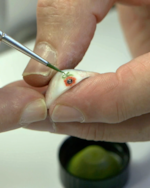Fred Harwin is an ocularist, and the Director for the Center for Ocular Prosthetics in Portland. A former medical illustrator, Harwin currently creates highly detailed artificial eyes. A process that combines tremendous artistic talent and deep anatomical knowledge, these prosthetics are tiny works of art that can change lives.
This conversation between "Oregon Art Beat" producer Eric Slade and Fred Harwin has been edited for clarity.
Q&A with Fred Harwin
Eric Slade: How do people lose an eye?
Fred Harwin: People lose an eye in a couple ways. One is they could be born without an eye, or with a non-seeing eye. You can lose an eye through some kind of pathology, some kind of disease, retina problems, cornea problems and such. Or lose an eye through trauma. All of a sudden, you know, the twig, the arrow from the bow and arrow, a Roman candle on Fourth of July — some strange things happen.
Slade: Why is a prosthetic eye so important?
Harwin: Our culture is visual. We look at somebody and we look in their eyes. If they don't look at us, we feel rejected. We engage each other by visual means. [An ocular prosthetic] gives a person back a feeling that they have an eye that looks like the other one and they feel more comfortable in our visual society.

Fred Harwin and patient Arturo Lucatero with his new ocular prosthetic.
OPB
Slade: What drew you to the field of ocular prosthesis? How did you get started?
Harwin: I've always drawn, all my life. That's the way I saw the world. And that's a way I communicated. [I was] very fortunate to go to medical illustration school. My first job out of college was at Wayne County General Hospital and I was the medical illustrator there. We did prosthetics [and] I was interested in beginning a facial prosthetic clinic at the Oregon Health & Sciences University. I went to 14 different medical centers in a year and spent time with each observing different ways of doing facial prosthetics. And then it happened to get down to eyes and found out I really, really enjoyed the process of making them.
Slade: Do you consider your work an art or a science?
Harwin: Actually, it's a combination of art and science. And what's interesting, in our society we think of them as opposing — the one is the creative side, one is the more pragmatic side — and there's a distance between them. I don't see it that way at all.
Slade: Tell us how you personalize each prosthetic.

Harwin painting a tiny, personal image on the top of the prosthetic.
OPB
Harwin: I always put a little painting on the top of each prosthesis to mark the top for them. And it's something that's personal for that person, something that relates to that person, something they like to do, a hobby. What it does is it involves the person in the piece. They're involved in it by making it personal. It's personal because there's something on there that they wish to have. An outdoor person, it's a picture of Mount Hood. A gardener, I'll do something that has to do with gardens.
Slade: What kind of change do you see in people with a new prosthesis?
Harwin: Oh, it can be profound. I’ve seen it change people’s complete life in terms of how they relate to others, getting married, making friends. I feel really fortunate and blessed, actually, to be able to be in a position where I can help other people. And it feels good. And I feel I’m having the opportunity in this field to use my art to help other people. I think of myself sometimes as a portrait painter. Only instead of painting someone’s portrait, I’m copying or painting their eye; making their eye a piece of sculpture that’ll become part of them.